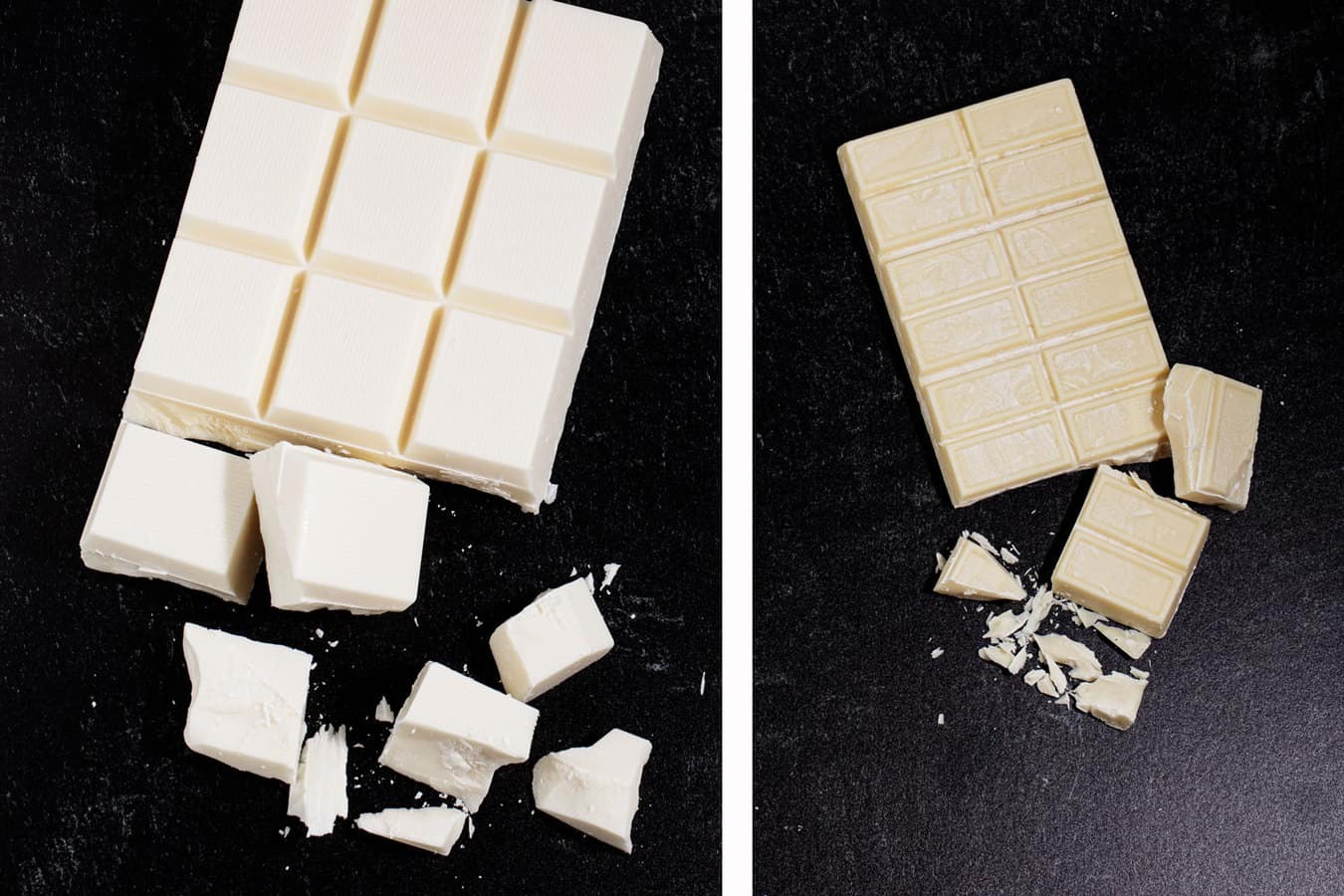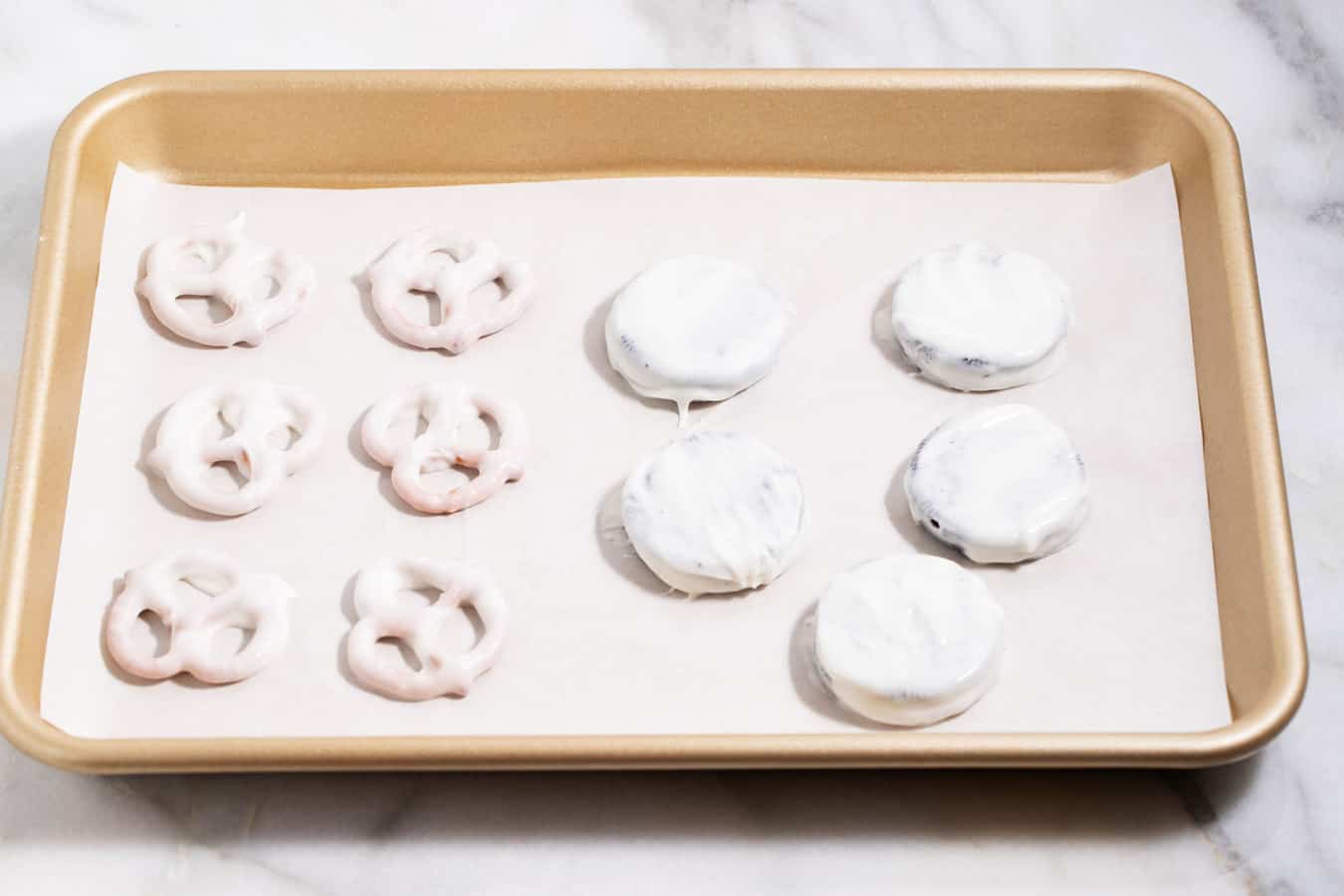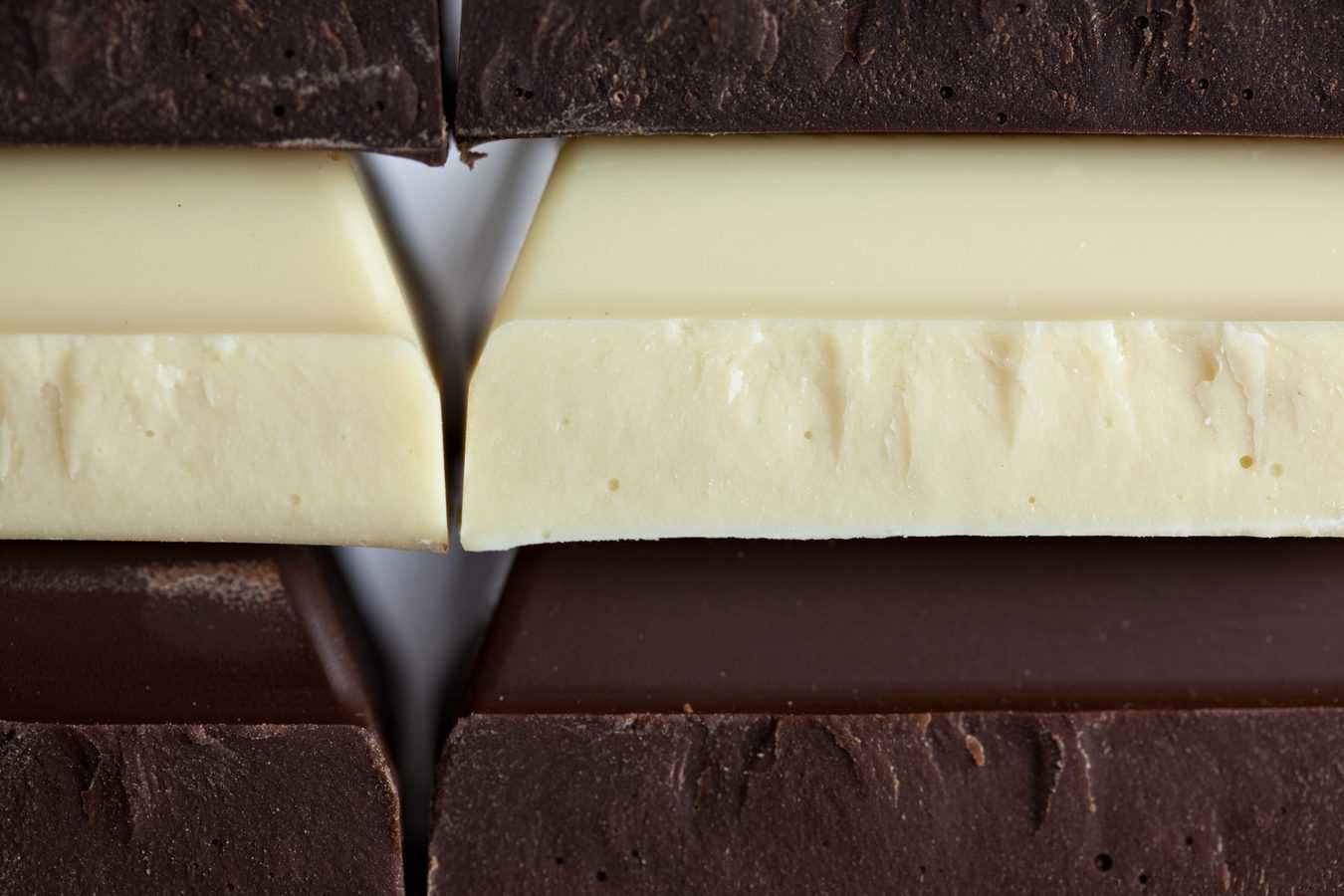Get the scoop on the similarities, differences, and uses of almond bark vs white chocolate. Always know which one to use to bake, drip, drizzle, and decorate.

Almond bark and white chocolate are popular confections used to drizzle, coat, or decorate desserts. Almond bark is meant to simulate white chocolate in taste, appearance, and function. However, it is not the same thing as white chocolate.
So, when should you use almond bark, and when should you use white chocolate?
The main differences between almond bark vs white chocolate are the taste, ingredients, and tempering requirement. White chocolate tastes better and is the best choice in baked goods.
But it can be challenging to work with because it requires tempering for most decorating needs. Conversely, almond bark is much easier to melt and decorate with. However, it tastes waxy and artificial and should not be mixed into baked goods.
Using the right one at the right time makes a difference in the prep time and taste of your final product. Keep reading to learn more about the differences between almond bark and white chocolate. Then you can decide which one to use.
RELATED: Read up on what to use in place of white chocolate.
Jump to:
- What is Almond Bark?
- What is White Chocolate?
- The Taste Showdown: Which Has the Best Taste?
- Melting Showdown
- Melting and Tempering White Chocolate
- Edible Decorations Showdown: Almond Bark vs White Chocolate
- Decorative Drizzles
- Dipping Foods with Almond Bark vs White Chocolate
- Making Candy Almond Bark (Almond Bark vs White Chocolate)
- FAQ
- Conclusion
- Get Your Chocolate Education
- Comments

What is Almond Bark?

Almond bark is a white chocolate-like confection that comes in a bar form. It is artificial chocolate made from sugar, milk solids, hydrogenated palm kernel oil, soy lecithin, and artificial flavor.
Because it does not have cocoa butter, it is considered a confectionery coating.
Does almond bark have nuts in it? One of the biggest misconceptions about almond bark is that it contains almonds. Almond bark does not have any nuts in it. It is purely candy coating. It got its name because it is widely used to coat nuts, like almonds.

You can find almond bark in your local grocery store in the baking aisle. Look at the front of the package. Notice that the product’s name is “vanilla-flavored coating.” The product name is in smaller print than “almond bark.”
Most people refer to this product as almond bark. That is what I’m calling it in this article too. Almond bark comes in two different flavors – chocolate and vanilla. Vanilla almond bark tastes like white candy melts.
Vanilla almond bark imitates the taste and appearance of white chocolate. It is less expensive than white chocolate because it contains vegetable oil instead of cocoa butter.
Oil is the key ingredient that eliminates the need to temper the product before using it. When you melt almond bark and then dip, coat, or decorate food, the coating will dry into a hard, smooth, and shiny finish.
What is a substitute for almond bark? Substitute any confectionery coating for almond bark. Almond bark’s cousins include candy wafers, meltables in round discs, and white candy melts. The general term for these items is candy coating or summer coating. Use these products interchangeably.
Almond Bark’s Strengths
- No need to temper before using.
- Easy to use.
- Easy to color with oil-based food coloring.
- Holds up well as a decoration.
Almond Bark’s Weaknesses
- Artificial taste.
- Cheap ingredients.
- Potentially harmful ingredient. Some almond bark brands may have titanium dioxide. Titanium dioxide is used as a coloring agent to make food more appealing.
Check the ingredient label and avoid products that contain titanium dioxide, if you can. Read more about potential food safety issues from this food additive.
How to Store Almond Bark

Store almond bark in an airtight container at cool room temperature. Stored properly, it should last up to a year. Check the use by date on the package.
Does almond bark go bad? Almond bark can go bad if it is stored improperly. It can become discolored and will not melt as smoothly. The texture can get rigid and crumbly, and it can develop an off-taste.
RELATED: Check out all the other helpful tutorials.
What is White Chocolate?

White chocolate is a candy made with cocoa butter, sugar, vanilla, and milk solids. While it is made from the fats from the cacao bean, it does not have cacao or chocolate liquor. The debate rages as to whether white chocolate is true chocolate.
True white chocolate comes in a bar, wafers, or baking chips. Any package of real chocolate will have cocoa butter on the ingredient list. If there is no cocoa butter, it is not real white chocolate.

White chocolate has many imitators, such as white morsels or Ghirardelli white melts. Use these products in baking as well as dipping, coating, or decorating. At times, finding white chocolate in your local grocery store is difficult.
White chocolate is more expensive than almond bark because it has cocoa butter in it. Unlike almond bark, white chocolate tastes great in baked goods, like cookies or cake.
It can also function as a decoration for desserts, but it can be tricky to work with because it must first be tempered before it is used.
The quality of the white chocolate is directly proportional to how easy it is to temper. Superior quality couverture white chocolate has a higher percentage of cocoa butter than standard white chocolate. The higher amount of cocoa butter makes couverture white chocolate ideal for tempering.
Use couverture white chocolate for special occasions. Order it online or search for it in specialty food stores.
It is possible, but not easy to temper grocery store white chocolate. After coating food, chill it to help the chocolate harden.
White Chocolate’s Strengths
- Creamy, smooth taste. Chop it and add to a cookie, muffin, or cake recipe. Or melt and add into a brownie batter, white hot chocolate, or fudge.
White Chocolate’s Weaknesses
- Requires tempering, which takes more time and can be more difficult.
- Tough to color because it is not naturally white. Instead, it is cream or pale yellow. Keep this in mind when mixing in oil-based food coloring.
How to Store White Chocolate

Store white chocolate at cool room temperature to prevent it from blooming. The cocoa butter separates from the other ingredients when chocolate blooms and the chocolate gets white streaks.
It is easier to see the white spots on dark chocolate, semi-sweet chocolate, or milk chocolate, but white chocolate gets the lines too.
Store white chocolate away from light in a cupboard or pantry. Keep it in an airtight container at cool room temperature (below 70° F at least, but ideally between 65° and 68° F).
The airtight container should protect it from other foods or spices nearby. The cocoa butter in the chocolate will pick up the smell of the foods around it.
Keep it out of the refrigerator. Chocolate kept in the fridge can get sugar bloom and pick up the odors from other foods. If stored properly, white chocolate can last 6 months to a year.
The Taste Showdown: Which Has the Best Taste?

What does almond bark taste like? Almond bark is cloying with a filmy artificial flavor. It can be chocolate or vanilla flavored. The texture is waxy, but it gets smooth as it melts on your tongue.
What does white chocolate taste like? White chocolate is less sweet than almond bark, with a hint of vanilla tones. The milky flavor slowly melts silky smooth on your tongue. White chocolate is softer than almond bark and has a more delicate snap.
White chocolate wins the taste showdown. Because of the smooth, creamy depth of flavor, always choose white chocolate over almond bark in baked goods. And when taste is a crucial feature of the food.
Melting Showdown
Almond bark vs white chocolate … which is easier to melt?
It is just as easy to melt almond bark as it is to melt white chocolate. However –
…more is required than a simple melting if the substance will be used to decorate.
Therefore, almond bark wins this round. It is easier to melt almond bark because after it melts, it is ready to use. No waiting for anything.
Melt the whole block or break it into pieces to melt. Melting it in the microwave is the quickest and easiest method.

Almond Bark Melting Directions:
- Place any amount of the almond bark bar in a microwave-safe bowl. You do not need to break it into pieces, but you can if it is easier to fit into the bowl.
- Heat on full power for 1 minute.
- Stir until smooth.
Melting and Tempering White Chocolate
Tempering is the thorn in white chocolate’s side. You must always temper it if you will be using it as a coating or an edible decoration.
Tempering white chocolate is heating it and then cooling it down. Then it is stable for making chocolate candy or coating foods.
Tempered white chocolate that has been dried and shaped in a candy mold will be hard, solid, and have a proper firm snap when broken.
Tempering white chocolate can be tricky. A whole batch can be ruined with just a few missteps.
If the tempering fails but the chocolate has not burned, it can be salvaged and used in other recipes. Use it for baked goods or hot chocolate. A tempering disaster does not have to mean wasted chocolate.
White Chocolate Tempering Directions

It is best to use a white chocolate bar rather than white chocolate chips (manufactured to hold their shape). You can melt white chocolate in the microwave or double boiler. The microwave is easiest, so try that method first.
- Use a large amount of chocolate. This will be easier than trying to temper a smaller volume. It’s best to use a pound of chocolate.
- Divide the chocolate into quarters. Put three-fourths of the chocolate into a microwave-safe bowl.
- Melt the chocolate in the microwave. Heat at 50% power for one minute. Stir. If necessary, heat again at 50% power in 30-second increments, stirring between each stint. When the chocolate is about 80% melted, stir until smooth.
- Add the remaining chunk. This will lower the temperature of the white chocolate. Keep stirring as it becomes integrated.
- Cool the chocolate. Keep stirring as the chocolate cools. It will need to reach 80° F (30° C).
- Test the temper. To check the temper of the chocolate, place a small amount on wax paper. It is adequately tempered if it sets within a few minutes.
When chocolate is tempered correctly, it is just as good as almond bark to coat food. And it is better tasting. However, tempering takes a while, and new bakers often find it challenging.
Edible Decorations Showdown: Almond Bark vs White Chocolate
Edible decorations include flat cut-outs, 3-D candy shapes, or decorative drizzles. In every case, almond bark is easier to use, but white chocolate tastes better.
Almond bark decorations made in chocolate molds dry hard and fast. White chocolate dries slower and may need to be refrigerated to speed up the drying time.
Why use almond bark vs white chocolate in edible decorations?
- Ready to use immediately after melting.
- Easy to color with oil-based food coloring.
- Fast drying and decorations remain hard. White chocolate decorations take longer to dry and are prone to losing their shape if handled repeatedly.
Decorative Drizzles

Drizzle decorations are different than edible decorations. Drizzle a cake with melted almond bark or a white chocolate ganache. The white chocolate is not tempered for a drizzle.
There is less chance for error when making ganache vs tempering white chocolate. A drizzle often takes the place of frosting.
Since you want the best-tasting cake, white chocolate wins this showdown. Even though almond bark is quicker and more manageable.
Only use almond bark as a drizzle if you need a colored drizzle.
Dipping Foods with Almond Bark vs White Chocolate

Dipping to Coat
The same tradeoff between taste and ease of use exists when coating food. Almond bark is easier to work with, and white chocolate tastes better.
Choosing between almond bark and white chocolate for dipping is not as clear-cut as with edible decorations or drizzles. Decorations aren’t always eaten (so use almond bark), and cakes with drizzles always are eaten (so choose white chocolate).
However, when you dip foods, you are eating the dessert with the candy coating. You aren’t eating the confection alone.
For example, when you eat a chocolate-covered pretzel, you taste the pretzel and the coating simultaneously.
I find that almond bark tastes better when it is coating something than when it is popped straight out of a chocolate mold with no other ingredient.
There is no clear winner between almond bark vs white chocolate when coating food. Choose the product you prefer.
What foods can you dip in almond bark or tempered white chocolate? You name it, you can dip it.

Some of the best foods to coat are:
- Oreo cookies
- Pretzels
- Strawberries
- Peanuts or pecans
- Ritz crackers peanut butter sandwich. Spread a Ritz cracker with peanut butter and top it with another Ritz cracker (to make a sandwich). Dip it in the coating for a white chocolate-covered peanut butter cracker sandwich.
- Christmas Chex mix
Dipping in a Chocolate Fountain or Melting Pot

Do not use almond bark in a chocolate fountain because it may clog it. However, you can use melted almond bark in a fondue pot. Then dip foods and enjoy.
Use white chocolate in a chocolate fountain. But first, add cocoa butter or oil to the melted white chocolate to thin it out. Then pour it into the chocolate fountain.

Melted white chocolate is also great in a fondue pot. Always melt first before pouring it into the dipping pot.
Making Candy Almond Bark (Almond Bark vs White Chocolate)

Now let’s talk about almond bark candy, which is where almond bark candy coating got its name.
The almond bark confection consists of a slab of chocolate sprinkled with almonds. Break the slab into chunks before serving it. The pieces will be irregularly shaped, but that is part of the charm.
This sweet treat is an easy recipe. Make almond bark candy with real chocolate or any type of candy coating. This may start sounding familiar by now, but the almond bark candy coating is easier to use when making this confection. However, white chocolate will taste better.
I prefer white chocolate because chocolate is the main ingredient and will be the primary food you taste.
White bark is an easy candy to make. Make your own almond bark candy with only two ingredients – almonds and white chocolate (or almond bark).
Directions:
- Line a baking sheet or jelly roll pan with parchment or wax paper.
- Melt the almond bark or melt and temper the white chocolate.
- Stir the almonds into the melted chocolate.
- Pour onto the baking sheet. Smooth into a thin layer.
- Chill for 2 hours in the refrigerator until the chocolate hardens.
- Break into pieces and serve.
Thick pieces of indulgent chocolate bark are a perfect gift for the holiday season.

If you want white chocolate bark with additional flavorings, mix in melted or crushed candy canes, along with the almonds.
Or switch out the almonds and replace them with cashews or macadamia nuts.
FAQ

Is almond bark the same as white candy coating?
Candy coatings are made from vegetable oils rather than cocoa butter, just like almond bark. Because of this, they won’t be classed as real chocolate.
Other similarities include:
- Low melting temperature
- No need to temper
Significant differences:
- Candy coatings come in a wide range of colors. Almond bark is white or chocolate brown.
- Candy coatings can be found in different flavors.
- Almond bark melts more smoothly and thinly than candy coatings, which often need shortening or oil to thin them.
Vanilla almond bark has milk solids (dairy). Therefore, it might not be right for people with a dairy allergy.
Almond bark candy coating does not have any animal products, so vegans can eat it. However, double-check each brand’s ingredient list before you buy it.
White chocolate does not have caffeine because caffeine is contained in the cocoa solids of the cacao bean.
However, because the fat and cocoa solids are separated to make cocoa butter, there might be a trace of caffeine in white chocolate.
Conclusion
Showdown complete. You are now an almond bark vs white chocolate expert. Though meant to be similar in taste and function, their differences are significant. Almond bark is easy to use, and white chocolate tastes better. Make all your usage decisions with those critical points in mind.
Get Your Chocolate Education

Check out these resources on all types of chocolate, including a showdown between candy melts vs. white chocolate.
- Discover the differences between white and dark chocolate in the ultimate showdown. Or compare white vs. milk chocolate.
- Learn how to melt chocolate chips on the stove. All kinds of chocolate covered.
- Going beyond the stove? Learn how to melt regular chocolate chips in the microwave. It is different than melting chocolate on the stove.
- Find out all the ways to melt white chocolate chips, plus how to melt any kind of white chocolate in the microwave.
- One of the best ways to improve chocolate baking is to learn how to measure chocolate chips correctly. It can be a little tricky.
- Learn some useful trivia too, like how many chocolate chips in an ounce, a tablespoon, and a cup.
Did you like this post? Then let's be social. FOLLOW ME on INSTAGRAM and PINTEREST to keep up with the latest happenings.





Comments
No Comments